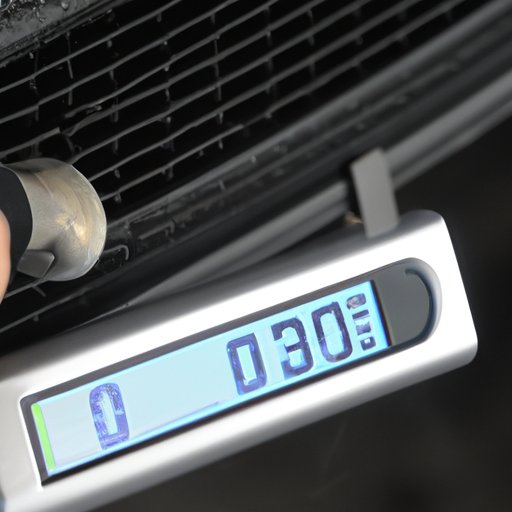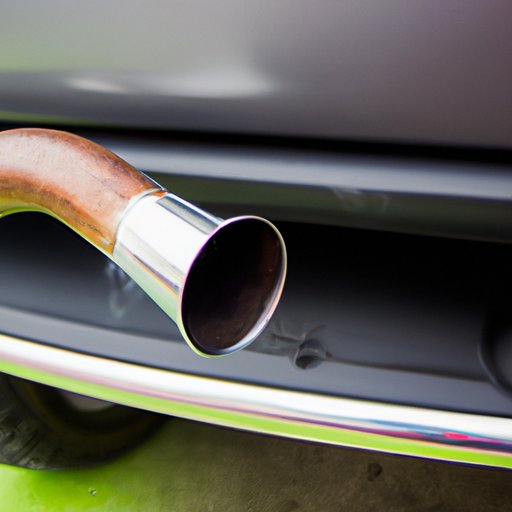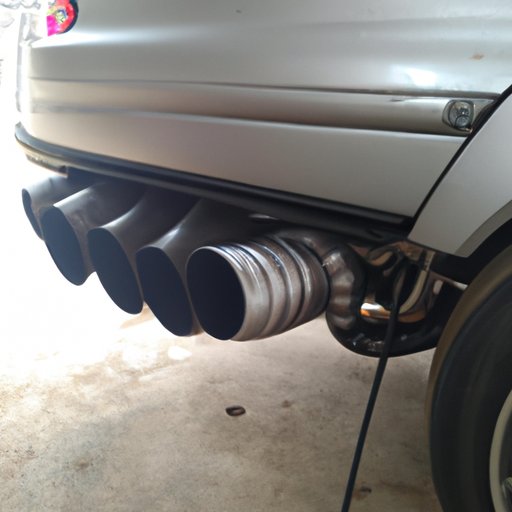Introduction
The exhaust system in your vehicle is responsible for carrying away exhaust gases from the engine. To do this, it must be able to withstand high temperatures. So just how hot does an exhaust get? In this article, we’ll explore what temperature ranges are normal for an automobile exhaust, as well as the potential risks of excessive heat.

Measuring Exhaust Temperatures in Automobiles
Exhaust temperatures can be measured in several different ways. The most common method is to use an infrared thermometer. This tool measures the surface temperature of the exhaust pipe. Another option is to use a thermocouple, which is a device that measures the temperature of the exhaust gases themselves. Both of these tools require some skill and knowledge to use correctly.
In addition to the tools mentioned above, you’ll need a few other items to measure exhaust temperatures in automobiles. These include a multimeter, a digital thermometer, and a pyrometer. A multimeter is used to measure voltage, current, and resistance. A digital thermometer is used to measure the ambient air temperature, while a pyrometer is used to measure the temperature of the exhaust gases inside the pipe.
What is the Average Temperature of an Automobile Exhaust?
The average temperature of an automobile exhaust is between 500-800°F (260-427°C). However, there are several factors that can affect the temperature of the exhaust. These include the size of the engine, the type of fuel being used, and the age of the vehicle. An older vehicle with a larger engine will typically have higher exhaust temperatures than a newer vehicle with a smaller engine.
In addition, the load on the engine and the speed at which it is running can also affect the exhaust temperature. If the engine is running at a high speed or under a heavy load, the exhaust temperature will be higher than if it is running at a lower speed or under a light load.
While the average temperature of an automobile exhaust is within the range of 500-800°F (260-427°C), it is important to note that some vehicles may exceed this range. For safety reasons, it is recommended that the maximum temperature of the exhaust should not exceed 1,000°F (538°C).
The Risks of Excessive Exhaust Heat
Excessive exhaust heat can cause damage to the internal components of the engine and lead to decreased fuel efficiency. If the exhaust temperature is too high, it can damage the exhaust valves, gaskets, and other parts of the engine. This can cause leaks and reduce the efficiency of the engine.
In addition, high exhaust temperatures can also cause the catalytic converter to overheat. This can lead to a decrease in fuel efficiency as the catalytic converter works less efficiently when it is too hot. Finally, excessive heat can also cause the spark plugs to wear out more quickly, leading to misfires and decreased performance.

How to Reduce Exhaust Temperatures in Your Vehicle
There are several things you can do to reduce the temperature of the exhaust in your vehicle. The first step is to inspect and replace any damaged or worn out parts. This includes the exhaust manifold, gaskets, and other components. If any of these parts are damaged or worn out, they should be replaced as soon as possible.
Next, a heat shield can be installed to help reduce the amount of heat transferring from the exhaust system to the rest of the engine. The heat shield acts as an insulator and prevents the heat from affecting other components. Additionally, keeping the engine well tuned will help to reduce exhaust temperatures. A well-tuned engine will run more efficiently and produce less heat.
Common Causes of Overheating Exhaust Systems
There are several common causes of overheating exhaust systems. One of the most common is leaking gaskets. Gaskets are used to seal the various parts of the exhaust system together and prevent leaks. If these gaskets become worn or damaged, they can allow hot exhaust gases to escape, which can cause the exhaust system to overheat.
Another common cause of excessive heat is a clogged catalytic converter. The catalytic converter helps to reduce harmful emissions from the engine. If it becomes clogged, it can restrict the flow of exhaust gases and cause the exhaust system to overheat. Finally, faulty or worn out spark plugs can also contribute to excessive heat in the exhaust system.

The Benefits of a Cooler Exhaust System
When the temperature of the exhaust system is kept within the recommended range, there are several benefits. First, it can improve the performance of the engine by allowing it to run more efficiently. Second, it can increase fuel economy by reducing the amount of heat transferred from the exhaust system to the rest of the engine. Finally, it can reduce emissions by preventing the catalytic converter from becoming excessively hot.
Conclusion
This article has explored the temperature of an automobile exhaust and the risks of excessive heat. We’ve also looked at how to reduce exhaust temperatures in your vehicle, as well as the benefits of a cooler exhaust system. Keeping the exhaust temperature within the recommended range can help to improve the performance, fuel economy, and emissions of your vehicle.
(Note: Is this article not meeting your expectations? Do you have knowledge or insights to share? Unlock new opportunities and expand your reach by joining our authors team. Click Registration to join us and share your expertise with our readers.)
